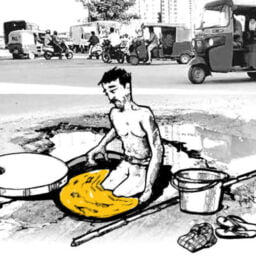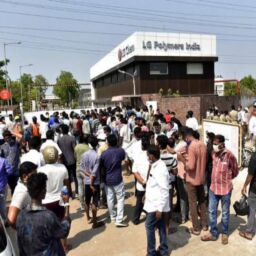“Caste is not a physical object like a wall of bricks on a line of barbed wire which prevents the Hindus from con-mingling and which has, therefore, to be pulled down. Caste is a notion; it is a state of mind.” [1]
– Dr. B.R. Ambdekar
The introduction of the book ‘The Grammar of Caste’[2] unfurls with the author describing the commemoration of the 70th Independence Day of India from the British colonialism. Little did the Prime Minister of the country hoisting the national flag at the Red Fort had the thought that a large number of Dalits had embarked upon a Dalit Asmita Yatra (the) Dalit Pride March from Ahmedabad ten days earlier, to the town of Una in Gujarat. The Dalits has assembled to declare themselves independent. Their demand for independence was from the harrowing and stigmatizing practices of manual scavenging and lifting the carcasses of animals. The occupations practiced by them were a stamp on their identity of being from a lower caste. Even after so many glorious years of independence, such ostracizing practices are in continuance. The people who had gathered at Una swore not to indulge in any of these tormenting occupations anymore for their livelihood. These people had just chosen the appropriate occasion for voicing their demands and demanding emancipation from such practices. And the place of Una was also chosen for all the right reasons as earlier several Dalit youths were chained and thrashed by a vigilante group for skinning a dead cow.
The caste system in India cannot be denied. It is a deep-rooted concept in our country which affects the people belonging to different social strata. A plethora of things have previously been written about the caste system. Ashwini Deshpande’s ‘The Grammar of Caste’ provides the readers with the economic discrimination in India on the basis of a citizen’s social status. The book takes into account the theme of ‘identity and the economics’ with respect to the Indian context. The book discusses whether social identities like caste, gender carved out the economic outcomes.
Although caste is a subject matter of a wide range of subjects, the bulk of it comes from Sociology, History and Political Science. The author takes into consideration a wide range of the major theories of discrimination. Casteism in India has been in practice since time immemorial and even though the constitution guarantees equality to all citizens regardless of the parameters like caste, religion, gender etc., this condemning practice can still be observed in the Indian society. There were fairly a lot of intermingling between the jaatis somewhere around 2000 years ago. Then gradually, endogamy emerged into practice which meant the custom of marrying only within the limits of local clan or tribe[3]. It created differences in the social fabric of castes. In ancient India, it was vocation that was used to define groups of people. There were around 6000 jaatis back then. The problem surfaced somewhere around 1000 years ago, when the jaatis started organizing themselves into along the hierarchy of “purity”. While some jaatis are considered to be pure, the others were labelled as impure right from the birth. The formation of groups was based on the professions carried out by them.
The author has put in unwavering efforts towards amalgamating the sociology with the economics to understand the inequalities that take shape due to birth, descent etc. The West also related its racism with India’s puritanical caste system. Although there can be parallels drawn between race and caste, there are still some differences between the two. Scholars of the caste system have denounced the racial theory of caste. The book provides an abstract idea about the interrelation between social identity and the marker and that the economic outcomes might be shaped more by social identity than by class status.
There are two main neo-classical theories discussed in essence. They are-
- a) Taste for discrimination and
- b) Statistical discrimination
The taste for discrimination model was put forth by Becker. According to this approach, an individual will discriminate another individual simple because he/she has a taste for it. Becker argues that individuals will discriminate even if it means a loss of income for them. On the other hand, the statistical discrimination model describes that the employers just simply accede to dominant stereotypes prevalent in the society without having complete information. There is a detailed comparison of Akerlof’s and Becker’s theories along with other theories. The book explains that the caste discrimination problem lies within the statistical discrimination framework. There is a great deal of reliance on Akerlof’s model of discrimination regarding the problem of caste discrimination. The author brings together the theories of both Indian as well as foreign writers in her quest for knowing the reasons for economic discrimination in the contemporary world. She does not fail to highlight the theories of Indian writers as well. She provides the deeply insightful writings of Indian theorists like Jotirao Phule, Periyar, B.R. Ambedkar. It helps the readers interpret the caste system in a more lucid manner.
The author also then takes into account a wide range of data sets using a variety of indicators. She points out that there is a lack of complete information as most of the economic literature gathered and compiled over the years was focused on individuals and not on inter-group disparities. She delves extensively into the two largest pan-India sets (after the census), that is, the National Sample Survey and the National Family and Health Survey. Even though there is lack of reliable data, the author attempts to bring the analysis of economic disparities to the reader. The author identifies five indicators from NFHS and those are, the occupation, education, landholding, assets and livestock. She compiles them together into what she calls the ‘Caste Development Index’. The divide between the rural and urban continues to be huge across all educational categories. Moreover, it is disheartening to witness that the schedule castes continue to be in the bottom rung in the category of illiteracy. Here, the author also mentions that there were some Dalit thinkers back in the colonial era, who endorsed the British rule as it provides for education to all.
Ashwini Deshpande dedicates an entire chapter to the overlapping of caste and gender, though identity has multiple parameters.[4] The Dalit women bear the dual hardships as they qualify in both the categories of being disadvantaged. Dalit women are considered to be the lowest in the caste hierarchy which makes them subject to dual discrimination[5]. The author aims at finding the answer to whether the tradeoff between material well-being and autonomy is still pervasive.
Further, the book attempts to first define discrimination, explaining how it can be understood in an explicit way and then by summarizing studies which attempt to gauge discrimination in the Indian context. As provided by Heckman, “Disparity in market outcomes does not prove discrimination.”
The last chapter “What is to be done?” deals with the intensely debated issue of politics. It brings to the fore the persistent question: do we need special policies to tackle discrimination and disparities or are the universal anti-poverty or redistributive policies enough to close the caste voids? The question before India is whether the affirmative action programme that is already in is appropriate or whether any new plan of action is required. The affirmative action plan is mainly caste- based and involves separate quotas for SC/STs and OBCs.
The book provides the data in a systematic manner of bar graphs and tables which makes it easier for a person novice to economics to contemplate the information provided. This book will appeal too many and will be appreciated by the readers for the considerable amount of efforts the author has put in calculating and analysing various kinds of information. It is of immense utility to researchers, policymakers and students of higher education.
Author(s) Name: Ishita Khandelwal (National Law University, Odisha)
References:
[1] Niranjan Rajadhyaksha, ‘B.R. Ambedkar in his own words’ (Livemint) < https://www.livemint.com/Home-Page/JHyUYYjoMzBFWSKuptd8LK/BR-Ambedkara-man-of-many-parts.html> accessed 5 September 2021
[2] Ashwini Deshpande, The Grammar of Caste (first published 2012, Oxford University Press)
[3] Devdutt Pattanaik, “Were Hindus always cateist?” (Devdutt) < https://devdutt.com/articles/were-hindus-always-casteist/> accessed 5 September 2021
[4] Ashwini Deshpande, “Overlapping Identities under Liberalization: Gender and Caste in India” 2010 EDCG < https://www.jstor.org/stable/10.1086/516763> accessed 6 September 2021
[5] ibid















